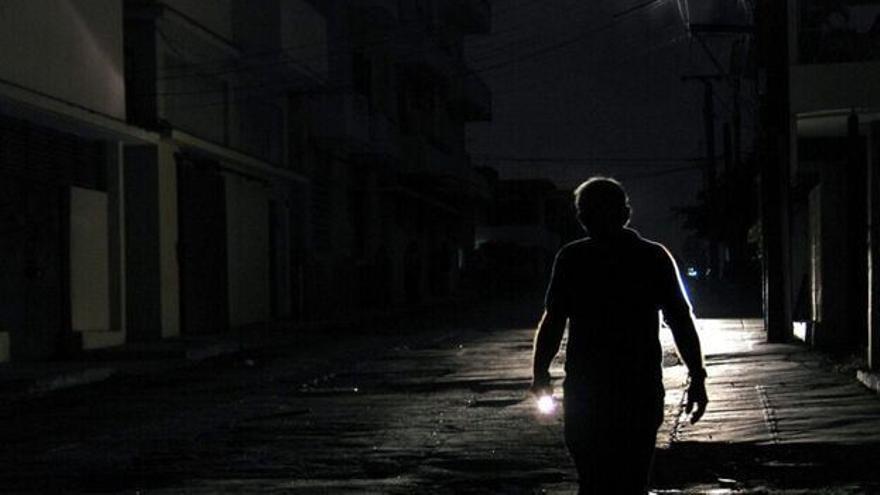
![]() 14ymedio, Havana, 9 August 2023 — It is one more year, just at the time of the highest temperatures, when Cubans face the growing shortage of energy and, with it, the dreaded blackouts. For this Wednesday, the Electric Union of Cuba (UNE) forecasts a deficit of 430 megawatts, with an availability of 2,650 MW and a maximum demand of 3,080 MW, so the “affectation” will be 500 MW during peak hours.
14ymedio, Havana, 9 August 2023 — It is one more year, just at the time of the highest temperatures, when Cubans face the growing shortage of energy and, with it, the dreaded blackouts. For this Wednesday, the Electric Union of Cuba (UNE) forecasts a deficit of 430 megawatts, with an availability of 2,650 MW and a maximum demand of 3,080 MW, so the “affectation” will be 500 MW during peak hours.
On Tuesday, the State notified that “the service was affected by a shortage of generation capacity throughout the day,” until the “affectation” was restored at 3:52 in the morning, a situation that coincided with high temperatures both day and night.
“We’re going to run out of refrigerators. One of the two I have overheated, and I had to defrost it to turn it on. The same thing happened to my neighbor, but with a few taps it turned on again,” said a resident of Key West in Central Havana, who suffered six blackouts this Tuesday. “To top it off, there were two this morning,” he says, with little hope that the situation will change.
Another inhabitant of the same neighborhood tells 14ymedio about the ordeal she had to go through when she visited the Joaquín Albarrán polyclinic in the municipality on Wednesday to get an electrocardiogram. There was no electric service at the site.
“When I arrived there was electricity, but about 20 minutes later it went out,” said the woman, who witnessed the doctors working without electricity. “I heard a doctor tell his patient that he couldn’t take his blood pressure if the light didn’t come on. That seemed strange to me because the blood pressure monitors I’ve seen are manual or battery-powered.”
Despite not knowing exactly what time the service would be restored – essential for performing electrocardiograms – she decided to wait. “If I left and the light came back on, I would have wasted all that work.”
At home, the situation was not far from that of the hospital. “When I arrived there was no service either, but it came back right away. Now you have to take advantage of it as long as it lasts,” she reasoned.
Centro Habana is not the only area that suffers the consequences of the fuel crisis and the failures of the electrical infrastructure. This week, the Havana municipality of Playa has also been one of the most affected.
On social networks, dissatisfied citizens have already uttered complaints and insults against the Electric Union due to the frequent outages and the inconsistency of the electric current. “I’ve been in a blackout for 9 hours. You can’t live like that,” one alleged while another denounced the cut at night: “It sucks when we don’t have electricity during prime time.”
In its report this Wednesday, the UNE also announced the exit of the Santa Cruz thermoelectric plant (Mayabeque) from the national system: unit 6 of Nuevitas, units 3 and 5 of Renté and unit 2 of Felton. Other units are under repair, and one of the patanas [floating generators] that produce energy from the ports was disabled due to lack of fuel.
In less than two hours this morning, the Electric Union had reported the explosion of three transformers in the capital municipalities of Plaza de la Revolución, Habana del Este and Arroyo Naranjo. Just moments before – in the early morning – it had managed to stabilize the breakdowns of the previous day.
Some of the citizens’ concerns translate into more global problems that escape the home context. People wonder, for example, the relevance of the banking reform — the so-called “bankification” — in a country that cannot generate enough kilowatts to keep ATMs, electronic collection devices or bank windows in operation. “Wanting to ’bankify’ without electricity is like building on water,” says a user who sees no future for the measure, no matter how much they “sell” it on Cuban Television.
Exactly one year ago, in August 2022, hundreds of inhabitants of Nuevitas (Camagüey) demonstrated against the long blackouts that affected the town. The event has been one of the biggest since the mass protests of July 11, 2021.
This summer has not been exempt from popular demonstrations either. At the end of July, a dozen residents of Centro Habana blocked the traffic at Belascoaín and San Lázaro in protest against the shortages in water and electricity services.
Rapper Eliexer Márquez El Funky, who shared a video of the event on his social networks, explained that the neighbors had been “more than three days without electricity” and that they would not move until the authorities took care of the problem. Some users, however, claimed that the days without service amounted to ten.
Faced with a situation that has now become unbearable, some citizens decide to raise their voices and others simply surrender to the impossibility of moving forward in a country without guarantees of well-being. “It’s very difficult to be calm here; you run in front and the problems come from behind, chasing you. There is no escape.”
Translated by Regina Anavy
____________
COLLABORATE WITH OUR WORK: The 14ymedio team is committed to practicing serious journalism that reflects Cuba’s reality in all its depth. Thank you for joining us on this long journey. We invite you to continue supporting us by becoming a member of 14ymedio now. Together we can continue transforming journalism in Cuba.
